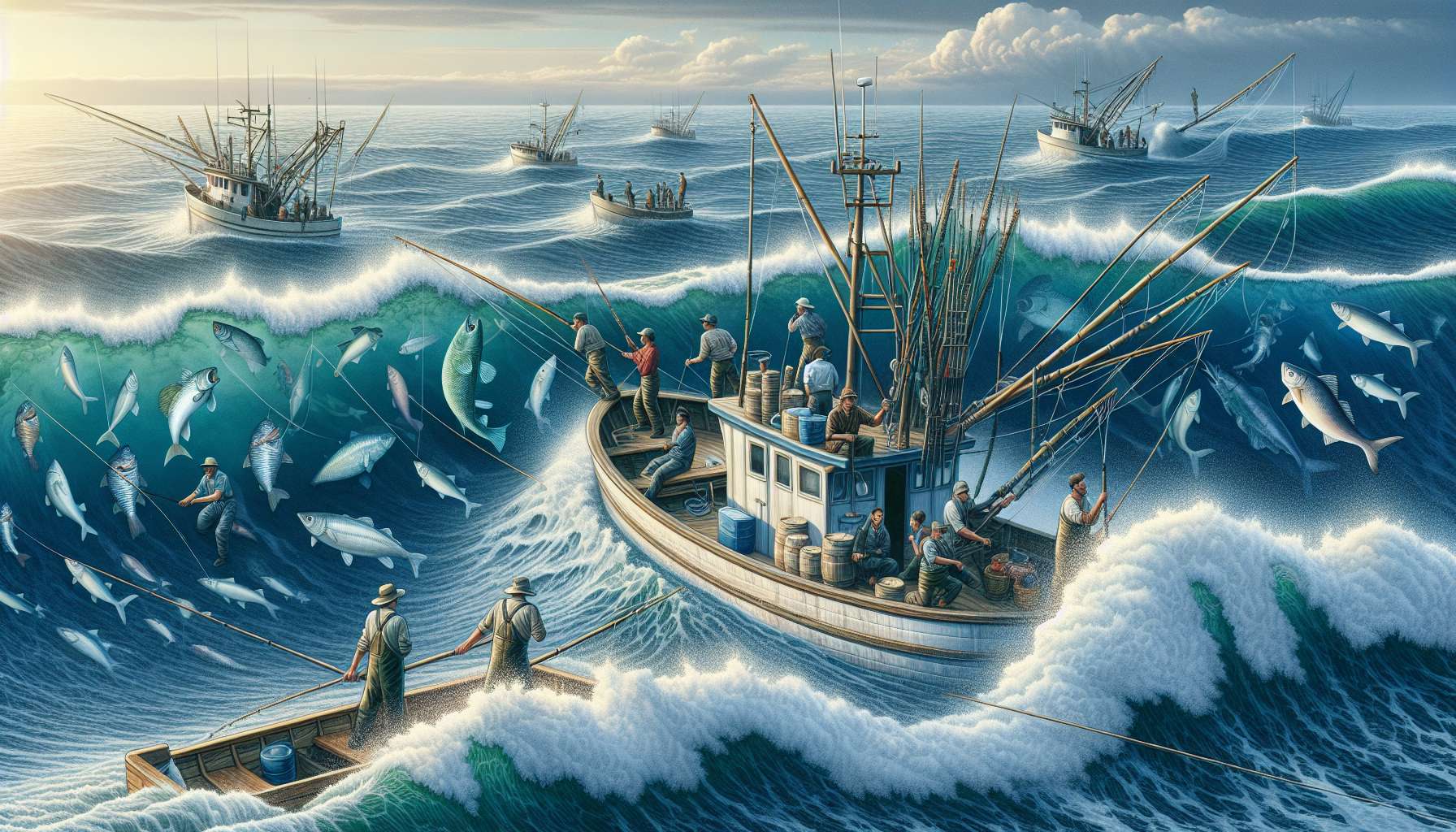Unlocking the Secrets of Deep Sea Fishing Techniques
Deep sea fishing, also known as offshore fishing, is a thrilling and challenging activity that attracts anglers from around the world. Far from the shore, where the waters are deep and teeming with a variety of fish species, deep sea fishing offers a unique and rewarding experience. However, mastering the art of deep sea fishing requires more than just a fishing rod and bait. It involves a combination of skill, knowledge, and technique to navigate the vast ocean and reel in the big catches.
Have you ever wondered what it takes to excel at deep sea fishing? What are the secrets to success in this exhilarating sport? In this comprehensive guide, we will delve deep into the world of deep sea fishing techniques, exploring the strategies, equipment, and tactics that can help you become a proficient angler in the open waters.
The Evolution of Deep Sea Fishing
Deep sea fishing has a long and storied history, dating back to ancient times when early civilizations relied on fishing as a vital food source. Over the years, advancements in technology and fishing practices have transformed deep sea fishing into a popular recreational activity. Today, anglers venture far offshore in pursuit of trophy fish such as marlin, tuna, and swordfish, testing their skills against the elements and the elusive creatures of the deep.
Modern deep sea fishing techniques have evolved to incorporate a wide range of strategies and equipment, allowing anglers to target specific species and maximize their chances of success. From trolling and bottom fishing to jigging and live baiting, each technique offers a unique approach to catching fish in the deep waters of the ocean.
Trolling: A Time-Tested Technique
One of the most popular deep sea fishing techniques is trolling, which involves dragging bait or lures behind a moving boat to attract fish. Trolling allows anglers to cover a large area of water and target fast-moving pelagic species such as tuna, mahi-mahi, and wahoo. By varying the speed of the boat and the depth of the bait, anglers can entice fish to strike, leading to exciting battles between angler and fish.
To engage in trolling effectively, anglers must use specialized trolling gear such as outriggers, downriggers, and planer boards to spread out multiple lines and create a realistic presentation. Choosing the right bait and lures is also crucial, as different fish species are attracted to specific colors, shapes, and sizes. By experimenting with different combinations and techniques, anglers can increase their chances of hooking into a trophy fish while trolling in the deep sea.
Bottom Fishing: Reeling in the Big Ones
Another popular deep sea fishing technique is bottom fishing, which involves dropping baited rigs to the ocean floor in search of bottom-dwelling fish such as grouper, snapper, and amberjack. Bottom fishing is a versatile and effective method for targeting a variety of species, as fish are drawn to the structure and cover found on the seabed.
When bottom fishing, anglers must use heavy-duty tackle and rigs to withstand the pressure of deep water and the strength of large fish. By anchoring the boat over productive fishing spots such as reefs, wrecks, and underwater structures, anglers can increase their chances of success and reel in the big ones. Patience and persistence are key when bottom fishing, as it may take time for fish to locate and strike the bait on the ocean floor.
Jigging: A High-Energy Approach
Jigging is a dynamic deep sea fishing technique that involves using specialized jigging lures to imitate the movements of injured baitfish and attract predatory species such as tuna, kingfish, and amberjack. By jerking the rod up and down in a rhythmic motion, anglers can create a realistic and enticing presentation that triggers aggressive strikes from hungry fish.
Successful jigging requires precise timing, coordination, and technique to effectively mimic the erratic movements of injured prey. Anglers must also be prepared for fast-paced battles with powerful fish that can test their strength and endurance. By mastering the art of jigging, anglers can experience the thrill of hooking into trophy fish in the deep waters of the ocean.
Live Baiting: Tempting the Predators
Live baiting is a tried-and-true deep sea fishing technique that involves using live baitfish or other live organisms to attract predatory fish such as marlin, sailfish, and sharks. By presenting a natural and lifelike bait to hungry predators, anglers can increase their chances of hooking into trophy fish and experiencing adrenaline-pumping battles on the open water.
When live baiting, anglers must use sturdy rigs and hooks to withstand the aggressive strikes of large fish. Properly rigging the bait and presenting it in a natural and realistic manner is essential for enticing predators to strike. By observing the behavior of the bait and adjusting the presentation accordingly, anglers can increase their success rate and land the fish of a lifetime.
Technological Advancements in Deep Sea Fishing
As technology continues to advance, deep sea anglers have access to a wide range of tools and equipment that can enhance their fishing experience and increase their chances of success. From fish finders and GPS devices to electric reels and drones, modern technology has revolutionized the way anglers locate, target, and catch fish in the deep waters of the ocean.
Fish finders utilize sonar technology to scan the underwater terrain and locate schools of fish, helping anglers pinpoint productive fishing spots and maximize their time on the water. GPS devices allow anglers to navigate with precision and return to productive fishing spots with ease, increasing their efficiency and effectiveness on the open sea.
Electric reels provide anglers with the power and speed needed to reel in large and stubborn fish from the depths, reducing fatigue and increasing the chances of landing trophy catches. Drones offer anglers a birds-eye view of the water and help them locate fish from above, providing valuable insights and opportunities for success.
Conservation and Sustainability in Deep Sea Fishing
As the popularity of deep sea fishing continues to grow, anglers are increasingly aware of the importance of conservation and sustainability in preserving the marine environment and fish populations for future generations. By practicing catch-and-release techniques, using circle hooks to reduce mortality rates, and adhering to size and bag limits, anglers can help protect the delicate balance of the ocean ecosystem.
Participating in citizen science initiatives such as tagging programs and data collection efforts allows anglers to contribute valuable information to scientific research and conservation efforts. By working together with researchers and conservation organizations, anglers can help ensure the long-term health and sustainability of marine resources and fish populations in the deep waters of the ocean.
Expert Opinions on Deep Sea Fishing Techniques
According to renowned deep sea angler and fishing guide, Captain Bill Smith, “Mastering the art of deep sea fishing requires a combination of skill, experience, and patience. By understanding the behavior of fish, the dynamics of the ocean, and the intricacies of different fishing techniques, anglers can increase their chances of success and reel in the big catches.”
Marine biologist and conservationist, Dr. Jane Miller, emphasizes the importance of sustainable fishing practices in deep sea fishing. “As anglers, we have a responsibility to protect the marine environment and preserve fish populations for future generations. By practicing catch-and-release and supporting conservation efforts, we can ensure that the ocean remains healthy and vibrant for years to come.”
Conclusion
In conclusion, deep sea fishing techniques offer anglers a thrilling and rewarding experience in the vast and challenging waters of the ocean. From trolling and bottom fishing to jigging and live baiting, each technique provides a unique and effective approach to targeting a variety of fish species in the deep sea. By mastering the art of deep sea fishing and incorporating modern technology and conservation practices, anglers can enjoy success and sustainability in this exhilarating sport.
Whether you’re a seasoned angler or a novice looking to explore the world of deep sea fishing, there’s always something new to learn and discover in the open waters. So grab your gear, set sail, and embark on an unforgettable deep sea fishing adventure today!




